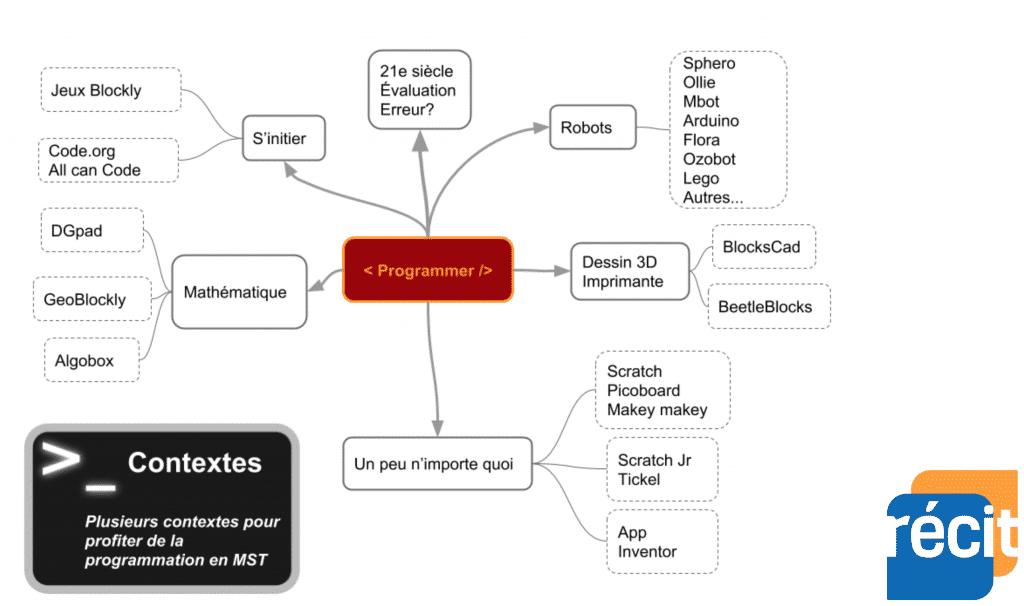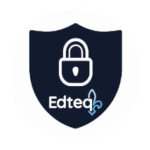Le 15 janvier dernier se tenait le deuxième Rendez-vous virtuel du RÉCIT. Six ateliers gratuits étaient offerts en ligne afin d’introduire les acteurs éducatifs à diverses thématiques pouvant être explorées dans le cadre du Plan d’action numérique en éducation. Les enregistrements de ces ateliers ainsi que les ressources présentées seront disponibles sur le site Web du RÉCIT.
Le premier webinaire présenté dans le cadre de ce Rendez-vous RÉCIT a mobilisé près de 100 personnes, preuve que l’intérêt pour la programmation gagne du terrain. Au terme de la présentation animée par les conseillers RÉCIT Pierre Lachance, Sonya Fiset, Stéphanie Rioux et Marc-André Mercier, les participants sont repartis avec des stratégies, des idées ainsi qu’une panoplie de ressources pour débuter ou poursuivre l’intégration de la programmation dans leur classe.
Pourquoi faire de la programmation en classe?
Quoi de plus stimulant que le témoignage d’une enseignante de mathématiques qui a fait le choix il y a quelques années d’intégrer des activités de programmation et qui vu les retombées positives sur l’engagement, la motivation et le sentiment d’accomplissement de ses élèves? Avant d’entrer dans le vif du sujet, Stéphanie Rioux a rappelé que la programmation permet non seulement d’aborder les connaissances du Programme de formation, il s’agit également d’un outil pour développer des compétences telles que la créativité et la résolution de problème.
Faire un choix en fonction de l’intention pédagogique
Marc-André Mercier a poursuivi le webinaire en rassurant les non-initiés : il n’est pas nécessaire de savoir enseigner la programmation pour en tirer profit dans sa pédagogie. L’enseignant n’a pas besoin d’avoir la réponse à tout. Il existe plusieurs outils pour initier ses élèves de façon progressive et en respectant son intention pédagogique. Par exemple, Jeux blockly et code.org sont deux plateformes qui favorisent l’apprentissage du code à travers la résolution de problème.
Afin d’aider les enseignants à identifier l’outil de programmation adapté à leur intention pédagogique et au niveau de leurs élèves, les animateurs ont proposé le schéma suivant :
« C’est important que les élèves réussissent des défis, et qu’ils aient envie de continuer » – Marc-André Mercier
Scratch vs. Algobox
Stéphanie Rioux et Sonya Fiset ont ensuite expliqué les avantages de deux interfaces fréquemment utilisées pour faire de la programmation en classe. Elles ont souligné que l’univers ludique de Scratch permet d’exploiter la créativité, d’engager les élèves dans des projets de courte durée. En outre, Scratch offre la possibilité de réaliser des projets interdisciplinaires et d’évaluer les activités de programmation.
Pour sa part, Algobox est une interface qui ressemble davantage à la programmation brute et qui permet d’aller plus loin en mathématiques tout en demeurant simple d’utilisation. Il est toutefois recommandé de travailler d’abord avec Scratch avant de se tourner vers Algobox.
« L’erreur n’est pas une fatalité en programmation, mais une opportunité pédagogique »
Des exemples de tâches
Par la suite, les deux conseillères ont partagé de nombreux exemples de tâches en mathématiques, ainsi que quelques exemples en univers social, en langues et en arts. Un partage qui a mis en évidence l’utilité de la programmation pour atteindre un objectif d’apprentissage, que celui-ci consiste à travailler les concepts géométriques (distance, angle, sens de rotation, répétition, périmètre, aire, rapport de similitude), à créer une carte du Canada ou à réaliser un jeu questionnaire sur les groupes de mots en français.
Les défis mathématiques de Stéphanie sont accessibles via ces deux Padlet :
Sonya a également insisté sur l’importance de faire réfléchir les élèves avant, pendant et après l’activité de programmation, ainsi que de leur faire garder des traces écrites de leur raisonnement mathématique.
Elle présente ses conseils utiles pour faire de la programmation via ce Padlet :
Pour aller plus loin : se former et s’informer
Les animateurs ont terminé le webinaire en rappelant qu’ils sont disponibles pour se déplacer dans les écoles et accompagner les enseignants partout au Québec. Que ce soit pour vous initier ou pour combler un besoin plus spécifique, n’hésitez pas à faire appel à l’équipe du RÉCIT MST qui compte désormais plusieurs nouveaux conseillers!
Par ailleurs, l’offre d’autoformation se trouve sur le site du Campus RÉCIT. Vous pouvez aussi visiter le site robot-tic.qc.ca, une initiative du RÉCIT MST pour centraliser les ressources et les expériences en classe qui touchent à la programmation et à la robotique. C’est d’ailleurs sur ce site que vous trouverez tous les liens présentés lors du webinaire.





 Recevez l'Info #DevProf et l'Hebdo pour ne rien manquer des nouveautés de l'École branchée!
Recevez l'Info #DevProf et l'Hebdo pour ne rien manquer des nouveautés de l'École branchée!




